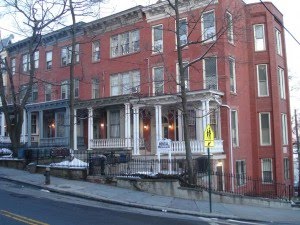413 Westervelt Avenue | A Staten Island Historical Home
Posted by Tom Crimmins Realty on
 This historic home is one among the row of houses along Westervelt Avenue designated, Horton's Row. The row of houses was constructed between 1880 and 1882 by Harry Horton, a prominent New York City banker and broker. It consisted of twelve identical attached masonry row houses, which were built as an affordable option for middle-class families on Staten Island. However, out of the twelve, 413 Westervelt is one of the four that remained intact.
This historic home is one among the row of houses along Westervelt Avenue designated, Horton's Row. The row of houses was constructed between 1880 and 1882 by Harry Horton, a prominent New York City banker and broker. It consisted of twelve identical attached masonry row houses, which were built as an affordable option for middle-class families on Staten Island. However, out of the twelve, 413 Westervelt is one of the four that remained intact.
Horton purchased the land for Horton's Row in 1870, but did not begin its construction until about a decade later. During the time, it was common to see many mansions and large estates among this portion of New Brighton, so Horton decided to create more affordable houses. The buildings are believed to have been…
1286 Views, 0 Comments


 The Britton Cottage is located at the foot of Court Place. It was originally located in New Dorp Beach but was moved to Historic Richmond Town in 1965. This is a one and a half story wood-framed house that was built around the 1670's. Additions to the house were made to the house later on. The house was first conveyed to Obadiah Holmes in 1677, Holmes was a clerk. It was believed that the house was used as a public building as well as a residential living area. In 1695 the cottage was conveyed to Nathaniel and Elizabeth Britton, they helped establish the English Presbyterian Church in Staten Island,1729. They lived in the cottage until 1714. Thomas Walton then resided in the cottage and few more people after. Eventually it was inherited by Harriet Lord…
The Britton Cottage is located at the foot of Court Place. It was originally located in New Dorp Beach but was moved to Historic Richmond Town in 1965. This is a one and a half story wood-framed house that was built around the 1670's. Additions to the house were made to the house later on. The house was first conveyed to Obadiah Holmes in 1677, Holmes was a clerk. It was believed that the house was used as a public building as well as a residential living area. In 1695 the cottage was conveyed to Nathaniel and Elizabeth Britton, they helped establish the English Presbyterian Church in Staten Island,1729. They lived in the cottage until 1714. Thomas Walton then resided in the cottage and few more people after. Eventually it was inherited by Harriet Lord…